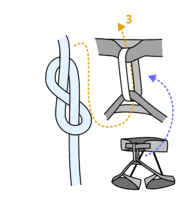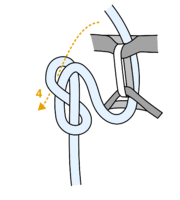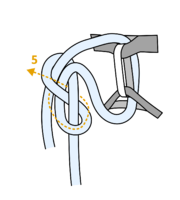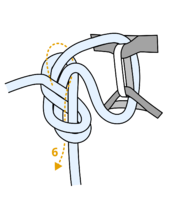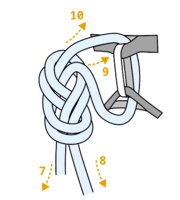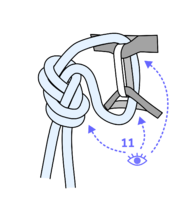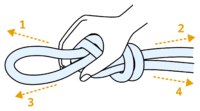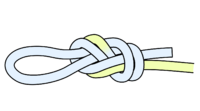Figure eight: Difference between revisions
Added stuck-prevention explanation |
|||
| Line 40: | Line 40: | ||
== Preventing from getting stuck == | == Preventing from getting stuck == | ||
As well studied and well-documented/illustrated by Hard is Easy,<ref>{{Cite AV media | people= Hard is easy | date=29 August 2020 | title=Why Figure 8 knot is NOT hard to untie! | url=https://www.youtube.com/watch?v=QAr-uHd8h8o | publisher=Hard is Easy | access-date=16 August 2025}}</ref> if the figure 8 is not | As well studied and well-documented/illustrated by Hard is Easy,<ref>{{Cite AV media | people= Hard is easy | date=29 August 2020 | title=Why Figure 8 knot is NOT hard to untie! | url=https://www.youtube.com/watch?v=QAr-uHd8h8o | publisher=Hard is Easy | access-date=16 August 2025}}</ref> if the figure 8 is not dressed and tightened properly before loading it, it tends to malform substantially after taking a fall, resulting in a knot which is hard and sometimes even almost impossible to untie. Rope parameters (diameter, stiffness) also play a role. Last very important parameter discovered was if the load strand goes on the top of the knot, or in the middle of the knot. | ||
[[File: fig8_tighten.png|200px]] | [[File: fig8_tighten.png|200px]] | ||
Revision as of 05:49, 16 August 2025
| Figure eight | |
|---|---|
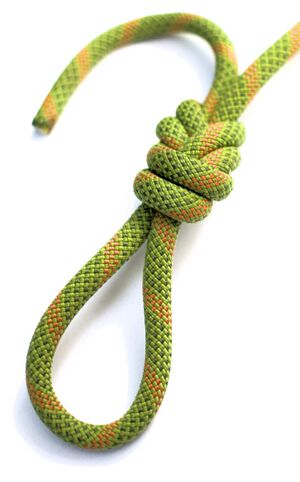 | |
| Other names | Figure 8, eight |
| Use(s) | Tying onto the rope end/middle, end-knot (single strand, marking) |
| Pros | Reliable, easy to inspect, low decrease of the rope strength |
| Cons | Tedious to untie after a lead fall in some cases, figure-eight bend is prone to rolling |
| Category | Knot |
| Strength | ~60-80% in normal (non-ring) load. Differs by author, type of measurement and rope[1] |
The Figure-eight loop is the most used knot for tying-in and one of the two widely accepted knots for tying-in at the end of the rope (the second being the re-threaded bowline).
Tying
Follow-through (tie-in on the rope end)
This method is the most commonly used method for tying-in onto a rope end.
Steps description: First take a bight of a rope and turn it end around itself making a half of the turn (1), then pull the rope through the upper eye (2) creating a figure-eight knot. Next pull the rope through the both eyes of the harness next to the belay loop (3). Continue by following-through the original figure-eight knot (4,5,6). Next tighten the rope ends (7,8,9,10) and at the end do not forget to check the knot and if the loop is threaded through the harness correctly (11). This step should be done also as a part of the partner check!
On a bight (tie in in a middle)
Steps description: Take a bight of a rope and do a half-turn around itself (1,2). Then pull the bight through the loop made by the turn (3) and slightly tighten the knot (4). If the knot is malformed, dress it properly for easier checking (5) and once finished, inspect the knot (6).
Preventing from getting stuck
As well studied and well-documented/illustrated by Hard is Easy,[2] if the figure 8 is not dressed and tightened properly before loading it, it tends to malform substantially after taking a fall, resulting in a knot which is hard and sometimes even almost impossible to untie. Rope parameters (diameter, stiffness) also play a role. Last very important parameter discovered was if the load strand goes on the top of the knot, or in the middle of the knot.
Rolling
TODO
References
- ↑ EDELRID Team (20 October 2020). "Strength reduction of textile materials by knots". edelrid. EDELRID GmbH & Co. KG. Retrieved 10 August 2025.
- ↑ Hard is easy (29 August 2020). Why Figure 8 knot is NOT hard to untie!. Hard is Easy. Retrieved 16 August 2025.


